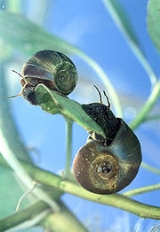
Planorbella trivolvis
Encyclopedia
Planorbella trivolvis is a species
of freshwater air-breathing snail
, an aquatic
pulmonate gastropod mollusk in the family
Planorbidae
, the ram's horn snails, or planorbids, which all have sinistral or left-coiling shells.
of this species is up to 18 mm.
, from the Arctic
areas of Canada
all the way south to Florida
. It has also been introduced in other parts of the world.
Species
In biology, a species is one of the basic units of biological classification and a taxonomic rank. A species is often defined as a group of organisms capable of interbreeding and producing fertile offspring. While in many cases this definition is adequate, more precise or differing measures are...
of freshwater air-breathing snail
Snail
Snail is a common name applied to most of the members of the molluscan class Gastropoda that have coiled shells in the adult stage. When the word is used in its most general sense, it includes sea snails, land snails and freshwater snails. The word snail without any qualifier is however more often...
, an aquatic
Aquatic animal
An aquatic animal is an animal, either vertebrate or invertebrate, which lives in water for most or all of its life. It may breathe air or extract its oxygen from that dissolved in water through specialised organs called gills, or directly through its skin. Natural environments and the animals that...
pulmonate gastropod mollusk in the family
Family (biology)
In biological classification, family is* a taxonomic rank. Other well-known ranks are life, domain, kingdom, phylum, class, order, genus, and species, with family fitting between order and genus. As for the other well-known ranks, there is the option of an immediately lower rank, indicated by the...
Planorbidae
Planorbidae
Planorbidae, common name the ramshorn snails or ram's horn snails, is a family of air-breathing freshwater snails, aquatic pulmonate gastropod mollusks....
, the ram's horn snails, or planorbids, which all have sinistral or left-coiling shells.
Description
All species within family Planorbidae have sinistral shells. The width of the shellGastropod shell
The gastropod shell is a shell which is part of the body of a gastropod or snail, one kind of mollusc. The gastropod shell is an external skeleton or exoskeleton, which serves not only for muscle attachment, but also for protection from predators and from mechanical damage...
of this species is up to 18 mm.
Distribution
This pond snail is native to North AmericaNorth America
North America is a continent wholly within the Northern Hemisphere and almost wholly within the Western Hemisphere. It is also considered a northern subcontinent of the Americas...
, from the Arctic
Arctic
The Arctic is a region located at the northern-most part of the Earth. The Arctic consists of the Arctic Ocean and parts of Canada, Russia, Greenland, the United States, Norway, Sweden, Finland, and Iceland. The Arctic region consists of a vast, ice-covered ocean, surrounded by treeless permafrost...
areas of Canada
Canada
Canada is a North American country consisting of ten provinces and three territories. Located in the northern part of the continent, it extends from the Atlantic Ocean in the east to the Pacific Ocean in the west, and northward into the Arctic Ocean...
all the way south to Florida
Florida
Florida is a state in the southeastern United States, located on the nation's Atlantic and Gulf coasts. It is bordered to the west by the Gulf of Mexico, to the north by Alabama and Georgia and to the east by the Atlantic Ocean. With a population of 18,801,310 as measured by the 2010 census, it...
. It has also been introduced in other parts of the world.
Parasites
- Planorbella trivolvis is an intermediate hostIntermediate hostA secondary host or intermediate host is a host that harbors the parasite only for a short transition period, during which some developmental stage is completed. For trypanosomes, the cause of sleeping sickness, humans are the primary host, while the tsetse fly is the secondary host...
for Echinostoma trivolvis.
Further reading
- CYNTHIA G. NORTON & JENNIFER M. BRONSON (2006) "THE RELATIONSHIP OF BODY SIZE AND GROWTH TO EGG PRODUCTION IN THE HERMAPHRODITIC FRESHWATER SNAIL, HELISOMA TRIVOLVIS". Journal of Molluscan Studies 72(2): 143-147.
- Norton C. G., Johnson A. F. & Mueller R. L. (2008) "Relative size influences gender role in the freshwater hermaphroditic snail, Helisoma trivolvis". Behavioral Ecology 19(6): 1122-1127.
- http://www.conchology.be/en/availableshells/searchresultsgallery.php?family=PLANORBIDAE
- http://www.cofc.edu/~fwgna/species/planorbidae/h_trivolvis.html
- http://www.itis.gov/servlet/SingleRpt/SingleRpt?search_topic=TSN&search_value=76671

